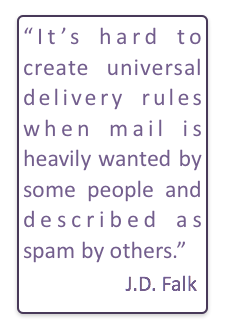Confusing the engineers
We went camping last weekend with a bunch of friends. Had a great time relaxing on the banks of the Tuolumne River, eating way too much and visiting.
On Saturday I was wearing a somewhat geeky t-shirt. It said 554: abort mission. (Thank you MessageSystems). At some point on Saturday every engineer came up to me, read my shirt and then looked at me and said “That’s not HTTP.”
That lead to various discussions about how their junior engineers don’t actually know SMTP at all. Why? Because the SMTP libraries just work. Apparently the HTTP libraries aren’t that great, so folks have to learn more about HTTP to troubleshoot and use them.
I’m sure there’s a joke in there somewhere: A Kindle engineer, an Android engineer and a robot engineer walk into a campsite… It did leave me thinking, though, about how it’s not that easy to run your own mail server these days. Gone are the days when running your own server was cost effective and easy. These days, there is just too much spam coming in. Crafting filters is a skilled job. It’s not that hard to run good filters. But to run good filters takes time to do well.
It did leave me thinking, though, about how it’s not that easy to run your own mail server these days. Gone are the days when running your own server was cost effective and easy. These days, there is just too much spam coming in. Crafting filters is a skilled job. It’s not that hard to run good filters. But to run good filters takes time to do well.
There are also a lot of challenges to sending mail. One of the discussions I had at the campsite was how hard it was to configure outbound mail. The engineer was helping a friend set up a website and trying to get the website to send notifications to the friend. But without setting up authentication the mail kept silently failing.
Of course, we do run our own mail server. But it’s our job and, in many ways, it keeps us honest. We don’t run many filters meaning we see what spammers are doing and can use our own experiences to better understand what commercial filters are dealing with.
For most people, though, I really think using a service is the right solution. Find one with filters that meet your needs and just pay them to deal with the headache.
